+ Open data
Open data
- Basic information
Basic information
| Entry | Database: PDB / ID: 7ad8 | ||||||
|---|---|---|---|---|---|---|---|
| Title | Core TFIIH-XPA-DNA complex with modelled p62 subunit | ||||||
 Components Components |
| ||||||
 Keywords Keywords | DNA BINDING PROTEIN / DNA repair / transcription factor | ||||||
| Function / homology |  Function and homology information Function and homology informationnucleotide-excision repair factor 1 complex / nucleotide-excision repair involved in interstrand cross-link repair / nucleotide-excision repair, DNA damage recognition / MMXD complex / core TFIIH complex portion of holo TFIIH complex / Cytosolic iron-sulfur cluster assembly / central nervous system myelin formation / positive regulation of mitotic recombination / hair cell differentiation / hair follicle maturation ...nucleotide-excision repair factor 1 complex / nucleotide-excision repair involved in interstrand cross-link repair / nucleotide-excision repair, DNA damage recognition / MMXD complex / core TFIIH complex portion of holo TFIIH complex / Cytosolic iron-sulfur cluster assembly / central nervous system myelin formation / positive regulation of mitotic recombination / hair cell differentiation / hair follicle maturation / nucleotide-excision repair factor 3 complex / nucleotide-excision repair, preincision complex assembly / CAK-ERCC2 complex / embryonic cleavage / DNA 5'-3' helicase / UV protection / regulation of cyclin-dependent protein serine/threonine kinase activity / G protein-coupled receptor internalization / transcription factor TFIIH core complex / transcription factor TFIIH holo complex / UV-damage excision repair / nuclear thyroid hormone receptor binding / transcription preinitiation complex / RNA Polymerase I Transcription Termination / regulation of mitotic cell cycle phase transition / DNA 3'-5' helicase / RNA polymerase II general transcription initiation factor activity / transcription factor TFIID complex / erythrocyte maturation / 3'-5' DNA helicase activity / hematopoietic stem cell proliferation / spinal cord development / RNA Pol II CTD phosphorylation and interaction with CE during HIV infection / RNA Pol II CTD phosphorylation and interaction with CE / HIV Transcription Initiation / RNA Polymerase II HIV Promoter Escape / Transcription of the HIV genome / RNA Polymerase II Promoter Escape / RNA Polymerase II Transcription Pre-Initiation And Promoter Opening / RNA Polymerase II Transcription Initiation / RNA Polymerase II Transcription Initiation And Promoter Clearance / Formation of the Early Elongation Complex / Formation of the HIV-1 Early Elongation Complex / bone mineralization / mRNA Capping / intrinsic apoptotic signaling pathway by p53 class mediator / ATPase activator activity / DNA topological change / RNA Polymerase I Transcription Initiation / protein localization to nucleus / hematopoietic stem cell differentiation / embryonic organ development / positive regulation of transcription initiation by RNA polymerase II / Tat-mediated elongation of the HIV-1 transcript / Formation of HIV-1 elongation complex containing HIV-1 Tat / transcription elongation by RNA polymerase I / response to UV / Formation of HIV elongation complex in the absence of HIV Tat / transcription by RNA polymerase I / RNA Polymerase II Transcription Elongation / Formation of RNA Pol II elongation complex / hormone-mediated signaling pathway / transcription-coupled nucleotide-excision repair / extracellular matrix organization / RNA Polymerase II Pre-transcription Events / DNA helicase activity / insulin-like growth factor receptor signaling pathway / maturation of SSU-rRNA from tricistronic rRNA transcript (SSU-rRNA, 5.8S rRNA, LSU-rRNA) / determination of adult lifespan / post-embryonic development / nucleotide-excision repair / chromosome segregation / TP53 Regulates Transcription of DNA Repair Genes / transcription initiation at RNA polymerase II promoter / transcription elongation by RNA polymerase II / promoter-specific chromatin binding / RNA Polymerase I Promoter Escape / cellular response to gamma radiation / base-excision repair / NoRC negatively regulates rRNA expression / Dual Incision in GG-NER / Transcription-Coupled Nucleotide Excision Repair (TC-NER) / response to toxic substance / Formation of TC-NER Pre-Incision Complex / spindle / multicellular organism growth / Formation of Incision Complex in GG-NER / intrinsic apoptotic signaling pathway in response to DNA damage / Dual incision in TC-NER / Gap-filling DNA repair synthesis and ligation in TC-NER / sequence-specific double-stranded DNA binding / intracellular protein localization / 4 iron, 4 sulfur cluster binding / response to oxidative stress / double-stranded DNA binding / 5'-3' DNA helicase activity / protein-macromolecule adaptor activity / in utero embryonic development / damaged DNA binding / transcription by RNA polymerase II Similarity search - Function | ||||||
| Biological species |  Homo sapiens (human) Homo sapiens (human) | ||||||
| Method | ELECTRON MICROSCOPY / single particle reconstruction / cryo EM / Resolution: 3.5 Å | ||||||
 Authors Authors | Koelmel, W. / Kuper, J. / Kisker, C. | ||||||
| Funding support |  Germany, 1items Germany, 1items
| ||||||
 Citation Citation |  Journal: Nucleic Acids Res / Year: 2020 Journal: Nucleic Acids Res / Year: 2020Title: The TFIIH subunits p44/p62 act as a damage sensor during nucleotide excision repair. Authors: Jamie T Barnett / Jochen Kuper / Wolfgang Koelmel / Caroline Kisker / Neil M Kad /   Abstract: Nucleotide excision repair (NER) in eukaryotes is orchestrated by the core form of the general transcription factor TFIIH, containing the helicases XPB, XPD and five 'structural' subunits, p62, p44, ...Nucleotide excision repair (NER) in eukaryotes is orchestrated by the core form of the general transcription factor TFIIH, containing the helicases XPB, XPD and five 'structural' subunits, p62, p44, p34, p52 and p8. Recent cryo-EM structures show that p62 makes extensive contacts with p44 and in part occupies XPD's DNA binding site. While p44 is known to regulate the helicase activity of XPD during NER, p62 is thought to be purely structural. Here, using helicase and adenosine triphosphatase assays we show that a complex containing p44 and p62 enhances XPD's affinity for dsDNA 3-fold over p44 alone. Remarkably, the relative affinity is further increased to 60-fold by dsDNA damage. Direct binding studies show this preference derives from p44/p62's high affinity (20 nM) for damaged ssDNA. Single molecule imaging of p44/p62 complexes without XPD reveals they bind to and randomly diffuse on DNA, however, in the presence of UV-induced DNA lesions these complexes stall. Combined with the analysis of a recent cryo-EM structure, we suggest that p44/p62 acts as a novel DNA-binding entity that enhances damage recognition in TFIIH. This revises our understanding of TFIIH and prompts investigation into the core subunits for an active role during DNA repair and/or transcription. | ||||||
| History |
|
- Structure visualization
Structure visualization
| Movie |
 Movie viewer Movie viewer |
|---|---|
| Structure viewer | Molecule:  Molmil Molmil Jmol/JSmol Jmol/JSmol |
- Downloads & links
Downloads & links
- Download
Download
| PDBx/mmCIF format |  7ad8.cif.gz 7ad8.cif.gz | 505.5 KB | Display |  PDBx/mmCIF format PDBx/mmCIF format |
|---|---|---|---|---|
| PDB format |  pdb7ad8.ent.gz pdb7ad8.ent.gz | 390.9 KB | Display |  PDB format PDB format |
| PDBx/mmJSON format |  7ad8.json.gz 7ad8.json.gz | Tree view |  PDBx/mmJSON format PDBx/mmJSON format | |
| Others |  Other downloads Other downloads |
-Validation report
| Summary document |  7ad8_validation.pdf.gz 7ad8_validation.pdf.gz | 808.6 KB | Display |  wwPDB validaton report wwPDB validaton report |
|---|---|---|---|---|
| Full document |  7ad8_full_validation.pdf.gz 7ad8_full_validation.pdf.gz | 823.2 KB | Display | |
| Data in XML |  7ad8_validation.xml.gz 7ad8_validation.xml.gz | 67.1 KB | Display | |
| Data in CIF |  7ad8_validation.cif.gz 7ad8_validation.cif.gz | 104.4 KB | Display | |
| Arichive directory |  https://data.pdbj.org/pub/pdb/validation_reports/ad/7ad8 https://data.pdbj.org/pub/pdb/validation_reports/ad/7ad8 ftp://data.pdbj.org/pub/pdb/validation_reports/ad/7ad8 ftp://data.pdbj.org/pub/pdb/validation_reports/ad/7ad8 | HTTPS FTP |
-Related structure data
| Related structure data |  4970M M: map data used to model this data |
|---|---|
| Similar structure data |
- Links
Links
- Assembly
Assembly
| Deposited unit | 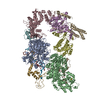
|
|---|---|
| 1 |
|
- Components
Components
-DNA chain , 2 types, 2 molecules JK
| #1: DNA chain | Mass: 15036.663 Da / Num. of mol.: 1 / Source method: obtained synthetically / Source: (synth.)  Homo sapiens (human) Homo sapiens (human) |
|---|---|
| #2: DNA chain | Mass: 15075.698 Da / Num. of mol.: 1 / Source method: obtained synthetically / Source: (synth.)  Homo sapiens (human) Homo sapiens (human) |
-Protein , 3 types, 3 molecules ABG
| #3: Protein | Mass: 89404.734 Da / Num. of mol.: 1 Source method: isolated from a genetically manipulated source Source: (gene. exp.)  Homo sapiens (human) / Gene: ERCC3, XPB, XPBC / Production host: Homo sapiens (human) / Gene: ERCC3, XPB, XPBC / Production host:  Trichoplusia ni (cabbage looper) / References: UniProt: P19447, DNA helicase Trichoplusia ni (cabbage looper) / References: UniProt: P19447, DNA helicase |
|---|---|
| #5: Protein | Mass: 87021.078 Da / Num. of mol.: 1 Source method: isolated from a genetically manipulated source Source: (gene. exp.)  Homo sapiens (human) / Gene: ERCC2, XPD, XPDC / Production host: Homo sapiens (human) / Gene: ERCC2, XPD, XPDC / Production host:  Trichoplusia ni (cabbage looper) / References: UniProt: P18074, DNA helicase Trichoplusia ni (cabbage looper) / References: UniProt: P18074, DNA helicase |
| #9: Protein | Mass: 31422.053 Da / Num. of mol.: 1 Source method: isolated from a genetically manipulated source Source: (gene. exp.)  Homo sapiens (human) / Gene: XPA, XPAC / Production host: Homo sapiens (human) / Gene: XPA, XPAC / Production host:  Trichoplusia ni (cabbage looper) / References: UniProt: P23025 Trichoplusia ni (cabbage looper) / References: UniProt: P23025 |
-General transcription factor IIH subunit ... , 5 types, 5 molecules FEDCI
| #4: Protein | Mass: 8060.362 Da / Num. of mol.: 1 Source method: isolated from a genetically manipulated source Source: (gene. exp.)  Homo sapiens (human) / Gene: GTF2H5, C6orf175, TTDA / Production host: Homo sapiens (human) / Gene: GTF2H5, C6orf175, TTDA / Production host:  Trichoplusia ni (cabbage looper) / References: UniProt: Q6ZYL4 Trichoplusia ni (cabbage looper) / References: UniProt: Q6ZYL4 |
|---|---|
| #6: Protein | Mass: 34416.008 Da / Num. of mol.: 1 Source method: isolated from a genetically manipulated source Source: (gene. exp.)  Homo sapiens (human) / Gene: GTF2H3 / Production host: Homo sapiens (human) / Gene: GTF2H3 / Production host:  Trichoplusia ni (cabbage looper) / References: UniProt: Q13889 Trichoplusia ni (cabbage looper) / References: UniProt: Q13889 |
| #7: Protein | Mass: 44481.996 Da / Num. of mol.: 1 Source method: isolated from a genetically manipulated source Source: (gene. exp.)  Homo sapiens (human) / Gene: GTF2H2, BTF2P44 / Production host: Homo sapiens (human) / Gene: GTF2H2, BTF2P44 / Production host:  Trichoplusia ni (cabbage looper) / References: UniProt: Q13888 Trichoplusia ni (cabbage looper) / References: UniProt: Q13888 |
| #8: Protein | Mass: 52245.156 Da / Num. of mol.: 1 Source method: isolated from a genetically manipulated source Source: (gene. exp.)  Homo sapiens (human) / Gene: GTF2H4 / Production host: Homo sapiens (human) / Gene: GTF2H4 / Production host:  Trichoplusia ni (cabbage looper) / References: UniProt: Q92759 Trichoplusia ni (cabbage looper) / References: UniProt: Q92759 |
| #10: Protein | Mass: 62116.492 Da / Num. of mol.: 1 Source method: isolated from a genetically manipulated source Source: (gene. exp.)  Homo sapiens (human) / Gene: GTF2H1, BTF2 / Production host: Homo sapiens (human) / Gene: GTF2H1, BTF2 / Production host:  Trichoplusia ni (cabbage looper) / References: UniProt: P32780 Trichoplusia ni (cabbage looper) / References: UniProt: P32780 |
-Non-polymers , 2 types, 7 molecules 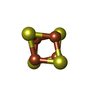


| #11: Chemical | ChemComp-SF4 / |
|---|---|
| #12: Chemical | ChemComp-ZN / |
-Details
| Has ligand of interest | N |
|---|
-Experimental details
-Experiment
| Experiment | Method: ELECTRON MICROSCOPY |
|---|---|
| EM experiment | Aggregation state: PARTICLE / 3D reconstruction method: single particle reconstruction |
- Sample preparation
Sample preparation
| Component |
| ||||||||||||||||||||||||
|---|---|---|---|---|---|---|---|---|---|---|---|---|---|---|---|---|---|---|---|---|---|---|---|---|---|
| Molecular weight | Experimental value: NO | ||||||||||||||||||||||||
| Source (natural) |
| ||||||||||||||||||||||||
| Source (recombinant) |
| ||||||||||||||||||||||||
| Buffer solution | pH: 7.5 | ||||||||||||||||||||||||
| Specimen | Embedding applied: NO / Shadowing applied: NO / Staining applied: NO / Vitrification applied: YES | ||||||||||||||||||||||||
| Vitrification | Cryogen name: ETHANE |
- Electron microscopy imaging
Electron microscopy imaging
| Experimental equipment |  Model: Titan Krios / Image courtesy: FEI Company |
|---|---|
| Microscopy | Model: FEI TITAN KRIOS |
| Electron gun | Electron source:  FIELD EMISSION GUN / Accelerating voltage: 300 kV / Illumination mode: FLOOD BEAM FIELD EMISSION GUN / Accelerating voltage: 300 kV / Illumination mode: FLOOD BEAM |
| Electron lens | Mode: BRIGHT FIELD |
| Image recording | Electron dose: 41 e/Å2 / Film or detector model: GATAN K2 SUMMIT (4k x 4k) |
- Processing
Processing
| CTF correction | Type: PHASE FLIPPING AND AMPLITUDE CORRECTION |
|---|---|
| 3D reconstruction | Resolution: 3.5 Å / Resolution method: FSC 0.143 CUT-OFF / Num. of particles: 227776 / Symmetry type: POINT |
 Movie
Movie Controller
Controller




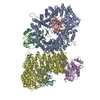
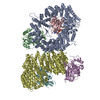

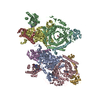



 PDBj
PDBj














































